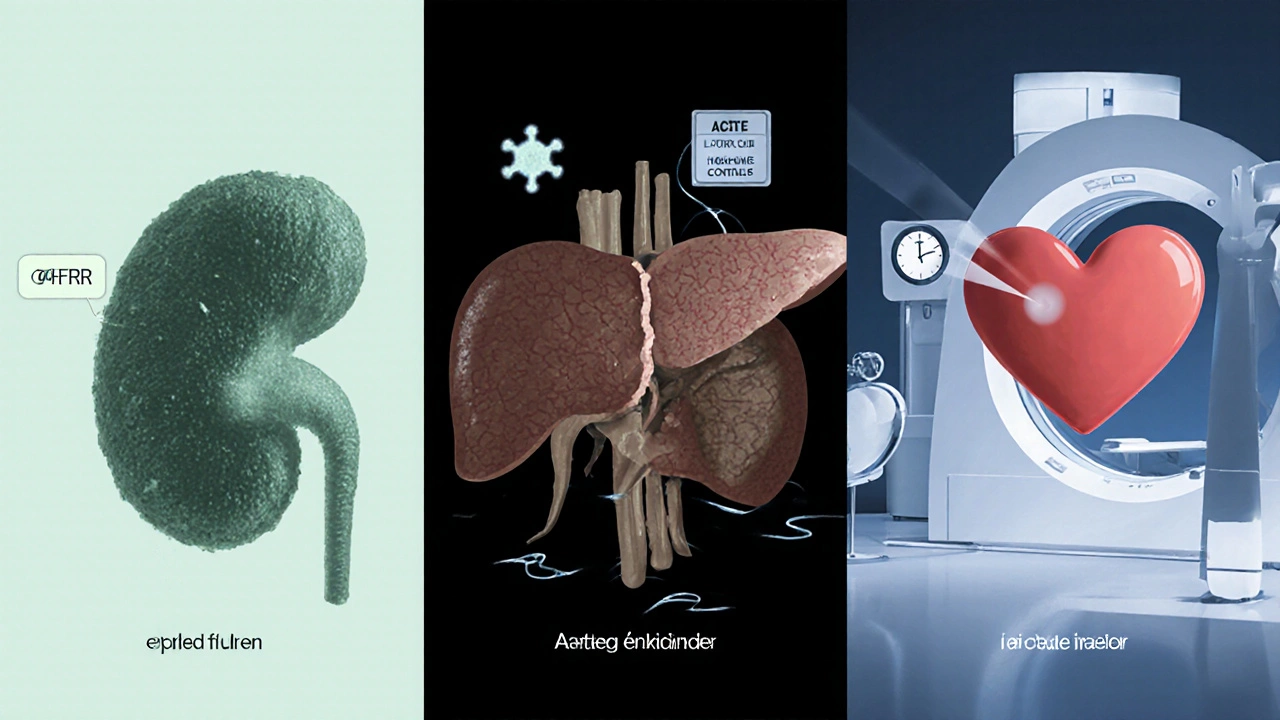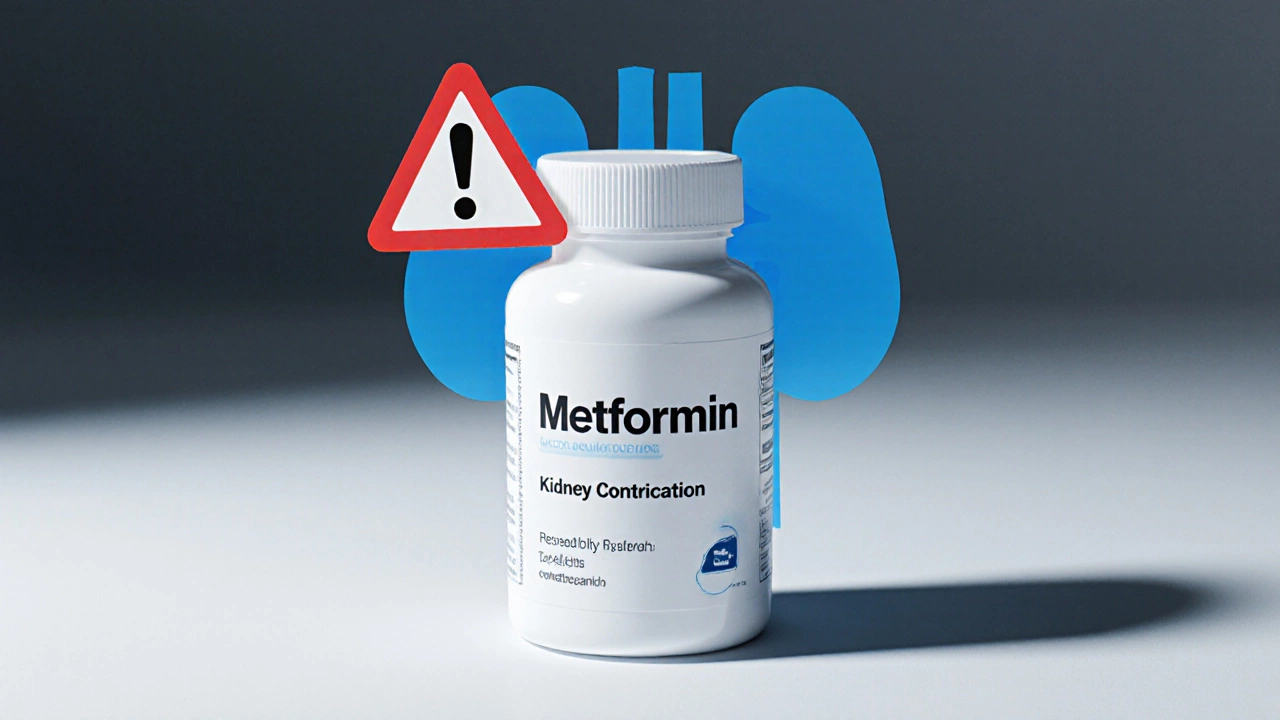Metformin Contraindication Checker
Check Your Metformin Safety
Answer these questions to determine if you have contraindications for metformin.
When managing blood sugar, Metformin is an oral biguanide medication used primarily for type2 diabetes. It’s cheap, effective, and helps with weight control, so it’s often the first drug doctors prescribe. But like any medicine, it isn’t safe for everyone. This guide breaks down exactly who should avoid metformin, why those groups are at risk, and what alternatives exist.
Quick Takeaways
- Severe kidney impairment (eGFR <30mL/min/1.73m²) is an absolute contraindication.
- Acute or chronic liver disease that raises lactate risk should steer you away.
- Pregnant or breastfeeding people need a doctor’s green light before starting.
- Recent contrast dye procedures require a temporary pause to prevent lactic acidosis.
- Heart failure patients with unstable hemodynamics should use metformin only under close supervision.
Why Metformin Can Be Dangerous in Certain Situations
The main safety concern with metformin is Lactic Acidosis - a rare but life‑threatening buildup of lactic acid in the blood. The drug itself doesn’t cause the condition, but it can worsen it when the body’s ability to clear lactate is compromised. Anything that reduces oxygen delivery, impairs kidney clearance, or damages liver function can tip the balance.
Kidney Function: The Most Common Deal‑Breaker
Metformin is cleared through the kidneys. When kidney filtration drops below a safe threshold, the drug can accumulate, raising lactate levels. Current guidelines set the cutoff at an estimated glomerular filtration rate (eGFR) of 30mL/min/1.73m². Below that, metformin is an metformin contraindications factor and must be stopped.
People with Chronic Kidney Disease (CKD) stages4‑5 fall into this zone. Even moderate CKD (eGFR 30‑45) calls for dose reduction and close monitoring, not a full ban.
Liver Disease and Impaired Lactate Clearance
The liver converts lactate back into glucose. Severe hepatitis, cirrhosis, or acute liver failure hampers this process, creating a perfect storm for lactic acidosis. If liver enzymes are markedly elevated (ALT/AST >3× upper limit) or the patient shows signs of hepatic decompensation (ascites, encephalopathy), metformin should be avoided.

Heart Failure: When the Heart Can’t Keep Up
In stable, well‑controlled heart failure, metformin may be tolerated, but in acute decompensation (pulmonary edema, low output) the reduced tissue perfusion raises lactate risk. The rule of thumb: if a patient is hospitalized for heart failure or has NYHA classIII‑IV symptoms, hold metformin until the heart stabilizes.
Contrast Dye Imaging: A Temporary Pause
Radiologic procedures that use iodinated contrast can cause a sudden decline in kidney function (contrast‑induced nephropathy). Because metformin’s clearance depends on the kidneys, guidelines recommend stopping it 48hours before and 48hours after the scan, provided kidney function remains normal.
Pregnancy, Breastfeeding, and Children
Metformin crosses the placenta. While many obstetricians prescribe it for gestational diabetes, the decision is case‑by‑case. Women with pre‑existing type2 diabetes who are already on metformin often continue under specialist care, but anyone starting the drug in pregnancy should discuss risks with a maternal‑fetal medicine doctor.
Breastfeeding mothers can usually stay on metformin; only a small amount enters breast milk and is considered safe. Children under 10years old are generally not given metformin unless they have specific endocrine disorders, and even then it’s under strict supervision.
Allergies and Drug Interactions
True allergic reactions to metformin are rare but can manifest as rash, itching, or swelling. If any of these appear, stop the drug immediately.
Other medicines can raise metformin levels or increase lactate risk. Notable culprits include:
- Carbonic anhydrase inhibitors (e.g., acetazolamide)
- Alcohol in excess - it impairs liver lactate metabolism.
- Certain antivirals (e.g., didanosine) which affect kidney function.
Always inform your prescriber about over‑the‑counter supplements, especially high‑dose vitamin B12, as metformin can already lower B12 levels over time.
How to Know If Metformin Is Right for You
Before starting, your doctor will check:
- Serum creatinine and eGFR - to assess kidney health.
- Liver function tests - to rule out severe hepatic disease.
- Heart status - especially recent admissions for heart failure.
- Pregnancy or planning to become pregnant.
If any of the above flags appear, the physician may either lower the dose, choose an alternative (like a SGLT2 inhibitor or a GLP‑1 receptor agonist), or simply hold off on any medication until the issue resolves.

Alternative Options When Metformin Isn’t Suitable
When metformin is off the table, several other classes can control blood glucose:
- SGLT2 inhibitors - work by excreting glucose in urine; good for heart‑failure patients.
- GLP‑1 receptor agonists - injectable options that also aid weight loss.
- DPP‑4 inhibitors - modest effect, low hypoglycemia risk.
- Insulin therapy - reserved for when oral agents can’t achieve targets.
Each has its own side‑effect profile, but they don’t carry the same lactic‑acidosis warning, making them safer for those with kidney or liver concerns.
Quick Reference Table: Who Should Avoid Metformin?
| Condition | Contraindication Level | Reason |
|---|---|---|
| eGFR < 30mL/min/1.73m² | Absolute | Impaired clearance → drug accumulation & lactate build‑up |
| Severe liver disease (Child‑Pugh C) | Absolute | Reduced lactate metabolism |
| Unstable heart failure (NYHA III‑IV) | Absolute/Conditional | Low perfusion → lactate accumulation |
| Recent iodinated contrast (within 48h) | Conditional | Risk of acute kidney injury |
| Pregnancy - not pre‑treated | Conditional | Potential fetal exposure; specialist review needed |
| Allergic reaction to metformin | Absolute | Risk of anaphylaxis or severe rash |
What to Do If You Fall Into a High‑Risk Category
Don’t panic. The first step is a conversation with your healthcare provider. They’ll likely:
- Order blood work to verify kidney and liver numbers.
- Adjust the dose or switch to a safer alternative.
- Set up regular monitoring (every 3‑6 months) if a reduced dose is used.
Key Takeaway Checklist
- Check eGFR before starting - <30mL/min = stop.
- Screen liver enzymes - severe elevation = avoid.
- Review heart‑failure status - unstable = hold.
- Plan any radiology with contrast - pause metformin.
- Discuss pregnancy or breastfeeding with a specialist.
Frequently Asked Questions
Can I take metformin if I have mild kidney disease?
If your eGFR is between 30‑45mL/min/1.73m², many doctors will prescribe a reduced dose (usually 500mg once daily) and monitor kidney function every 3 months. Below 30, metformin should be stopped.
Is metformin safe during pregnancy?
Women already on metformin for pre‑existing type2 diabetes often continue under specialist care because the drug helps control glucose without causing hypoglycemia. Starting metformin in pregnancy should only happen after a thorough risk‑benefit discussion.
What symptoms signal lactic acidosis?
Look for rapid breathing, muscle pain, abdominal discomfort, weakness, and a feeling of being unusually cold. If any appear while taking metformin, seek emergency care immediately.
Do I need to stop metformin before an MRI with contrast?
Yes. Pause the drug at least 48hours before the scan and resume 48hours after, provided post‑scan kidney tests are normal.
What alternatives are best for someone with heart failure?
SGLT2 inhibitors (e.g., empagliflozin) have proven cardiovascular benefits and are often the go‑to choice when metformin isn’t safe. GLP‑1 receptor agonists are another option, especially if weight loss is a goal.
